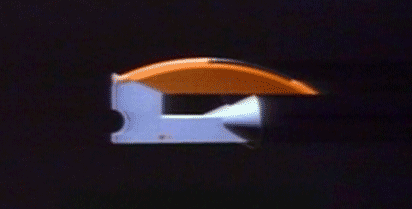No edit summary |
No edit summary |
||
| Line 7: | Line 7: | ||
"When MAGI was first started in 1966, we were working primarily with the government doing what's called nuclear radiation transport. Worrying about, if you had a nuclear reactor, how much radiation would come out and what kind of radiation dose would people get. The way we did that was to describe three dimensional objects, and then follow around the nuclear radiation, follow it through its path through the material. One day we realized that if we followed light rays instead of nuclear radiation, we could simulate photography. We could simulate following the light rays from the sun to the object, from the object in through the camera lens to the film. If we could just calculate how much light hit each point on the film, we could make a photograph of things." |
"When MAGI was first started in 1966, we were working primarily with the government doing what's called nuclear radiation transport. Worrying about, if you had a nuclear reactor, how much radiation would come out and what kind of radiation dose would people get. The way we did that was to describe three dimensional objects, and then follow around the nuclear radiation, follow it through its path through the material. One day we realized that if we followed light rays instead of nuclear radiation, we could simulate photography. We could simulate following the light rays from the sun to the object, from the object in through the camera lens to the film. If we could just calculate how much light hit each point on the film, we could make a photograph of things." |
||
| + | <br><br> |
||
| − | |||
| − | [[Image:Lightcycle_behindthescenes.gif |
+ | [[Image:Lightcycle_behindthescenes.gif]]<Br><br>In 1967, MAGI developed a software program called, "Synthavision" to create CGI images and movies. Synthavision was one of the first systems to implement the later concept of ray-tracing for making images. The software was constructive solid geometry (CSG) system, in that the geometry was solid primitives with combinatorial operators (such as Boolean operators). Synthavision's modeling method doesn't use polygons or wireframe meshes that most CGI companies use today. The combination of the solids modeling and ray tracing (later to become plane firing) made it a very robust system that could generate high quality images. In 1972, MAGI/SynthaVision was started by Robert Goldstein, with Bo Gehring and Larry Elin covering the design and film/tv interests, respectively. |
MAGI created the world's first CGI advertisement for IBM. It featured 3D letters that flew out of an office machine. |
MAGI created the world's first CGI advertisement for IBM. It featured 3D letters that flew out of an office machine. |
||
Revision as of 18:29, 21 October 2007
MAGI, aka Mathematical Applications Group, Inc., was one of the four companies hired to create the CGI animation for the movie Tron. MAGI/Synthavision was responsible for the most of the CGI animation in the first half of Tron, while Triple-I work mainly on the second half of the movie.
MAGI modeled and animated the Lightcycles, Recognizers and Tanks.
Beginnings
MAGI was founded in 1966 by Dr. Mittelman. In Beyond Tron, Dr. Mittelman talked about the original purpose of MAGI and the discovery of using ray tracing to create CGI images:
"When MAGI was first started in 1966, we were working primarily with the government doing what's called nuclear radiation transport. Worrying about, if you had a nuclear reactor, how much radiation would come out and what kind of radiation dose would people get. The way we did that was to describe three dimensional objects, and then follow around the nuclear radiation, follow it through its path through the material. One day we realized that if we followed light rays instead of nuclear radiation, we could simulate photography. We could simulate following the light rays from the sun to the object, from the object in through the camera lens to the film. If we could just calculate how much light hit each point on the film, we could make a photograph of things."

In 1967, MAGI developed a software program called, "Synthavision" to create CGI images and movies. Synthavision was one of the first systems to implement the later concept of ray-tracing for making images. The software was constructive solid geometry (CSG) system, in that the geometry was solid primitives with combinatorial operators (such as Boolean operators). Synthavision's modeling method doesn't use polygons or wireframe meshes that most CGI companies use today. The combination of the solids modeling and ray tracing (later to become plane firing) made it a very robust system that could generate high quality images. In 1972, MAGI/SynthaVision was started by Robert Goldstein, with Bo Gehring and Larry Elin covering the design and film/tv interests, respectively.
MAGI created the world's first CGI advertisement for IBM. It featured 3D letters that flew out of an office machine.
